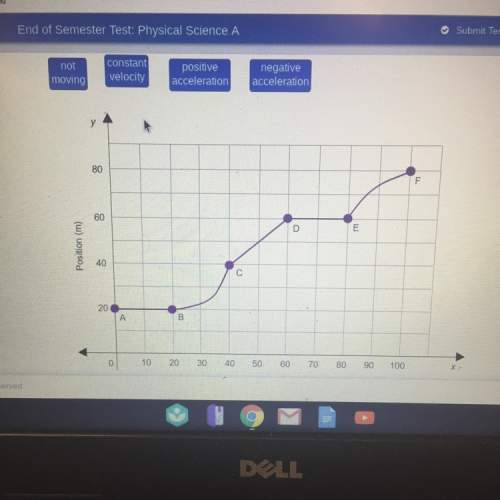

Answers: 2
Another question on Physics

Physics, 22.06.2019 11:30
Water is siphoned from a large tank and discharges into the atmosphere through a 50-mm diameter tube. the end of the tube is b = 2.1 m below the tank bottom which is a = 7.4 m deep, and viscous effects are negligible. determine the maximum height h over which the water can be siphoned without cavitation occurring. atmospheric pressure is 101.4 kpa, and the water vapor pressure is 1.79 kpa (absolute)
Answers: 3

Physics, 22.06.2019 16:00
An charge with mass m and charge q is emitted from the origin, (x,y)=(0,0). a large, flat screen is located at x=l. there is a target on the screen at y position y(h), where y(h) > 0. in this problem, you will examine two different ways that the charge might hit the target. ignore gravity in this problem. 1.assume that the charge is emitted with velocity v(0) in the positive x direction. between the origin and the screen, the charge travels through a constant electric field pointing in the positive y direction. what should the magnitude e of the electric field be if the charge is to hit the target on the screen? express your answer in terms of m, q, y(h), v(0), and l. 2.now assume that the charge is emitted with velocity v(0) in the positive y direction. between the origin and the screen, the charge travels through a constant electric field pointing in the positive x direction. what should the magnitude e of the electric field be if the charge is to hit the target on the screen? express your answer in terms of m, q, y(h), v(0), and l.
Answers: 1

Physics, 22.06.2019 22:00
Aviolently rotating column of air is formed around a region of extremely low air pressure above land. which of these weather conditions is most likely to follow? blizzard cyclone tornado hurricane
Answers: 1

Physics, 22.06.2019 23:30
Newton's law of cooling states that the rate of change in the temperature t(t) of a body is proportional to the difference between the temperature of the medium m(t) and the temperature of the body. that is, startfraction dt over dt endfraction equals upper k left bracket upper m left parenthesis t right parenthesis minus upper t left parenthesis t right parenthesis right bracket , where k is a constant. let kequals0.04 left parenthesis min right parenthesis superscript negative 1 and the temperature of the medium be constant, m(t) font size decreased by 3 equivalent font size decreased by 3 294 kelvins. if the body is initially at 369 kelvins, use euler's method with hequals0.1 min to approximate the temperature of the body after (a) 30 minutes and (b) 60 minutes.
Answers: 2
You know the right answer?
An object has a momentum of 56.59 kg*m/s and a velocity of 5.3 m/s. What 1 point
is the mass of the...
Questions


Mathematics, 01.03.2021 16:20




Mathematics, 01.03.2021 16:30




Mathematics, 01.03.2021 16:30


Mathematics, 01.03.2021 16:30





Mathematics, 01.03.2021 16:30

Mathematics, 01.03.2021 16:30

Mathematics, 01.03.2021 16:30

Geography, 01.03.2021 16:30






